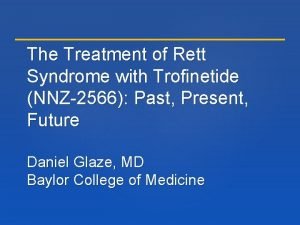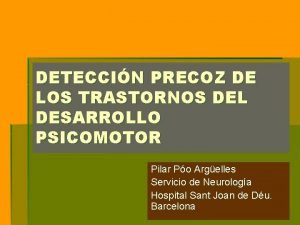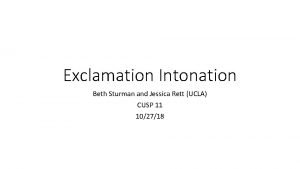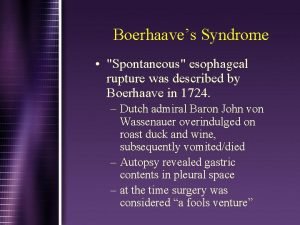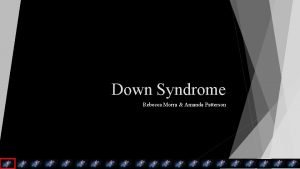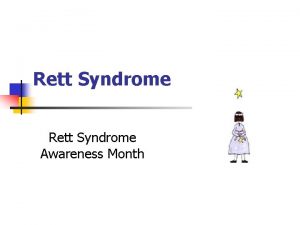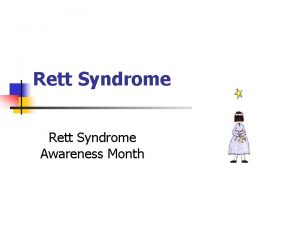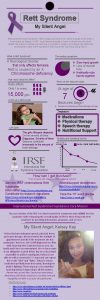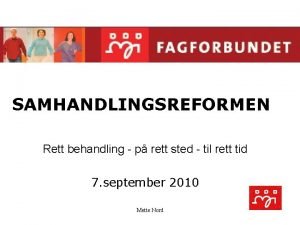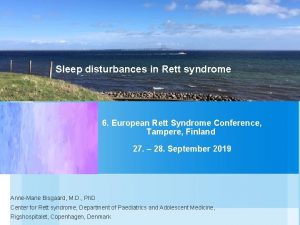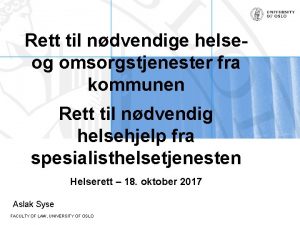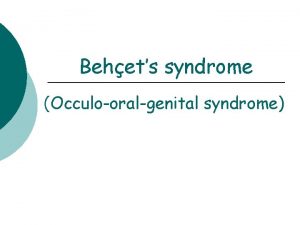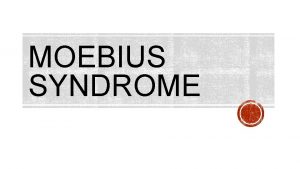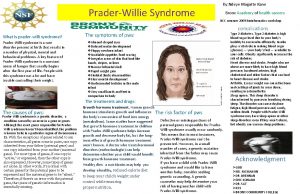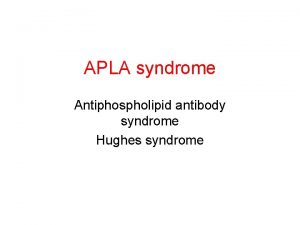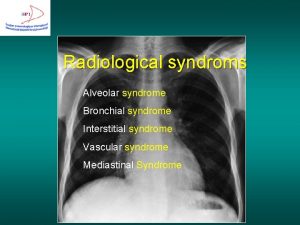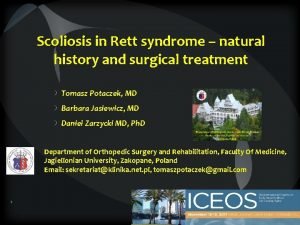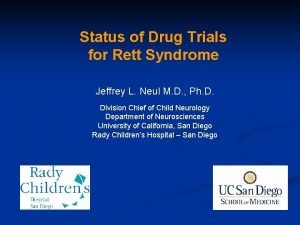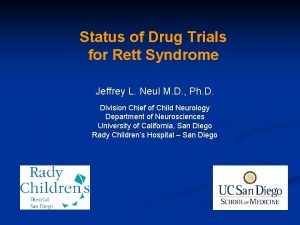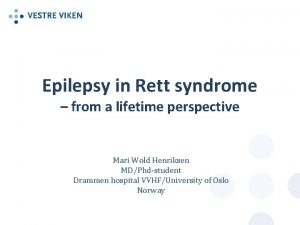The Treatment of Rett Syndrome with Trofinetide NNZ2566




























- Slides: 28

The Treatment of Rett Syndrome with Trofinetide (NNZ-2566): Past, Present, Future Daniel Glaze, MD Baylor College of Medicine

The Treatment of Rett Syndrome with Trofinetide (NNZ-2566): Past, Present, Future Jeffrey Neul MD Ph. D UCSD, for: Daniel Glaze, MD Baylor College of Medicine

Multicenter Trials of Trofinetide • Past: Neu-2566 -RETT-001 Phase 2 in Adolescents and Adults with RTT • Present: Neu-2566 -Rett 002 Phase 2, Children with RTT • Future: Anticipated Phase 3 Trial, Pediatric and Adult RTT Sponsor: Neuren Pharmaceuticals Rett 001 and 002 partially funded by Rett. Syndrome. org

Trofinetide (NNZ-2566) • • • IGF-1 is a naturally occurring growth factor in the brain Glypromate (GPE) separates from IGF-1 in the brain IGF-1 and GPE maintain and restore equilibrium in 5 the brain trofinetide

Trofinetide (NNZ-2566) Trofinetide is a synthetic analogue of GPE • Able to cross blood brain barrier • Suitability as an oral medication: 50 -60% bioavailable • Influences processes underlying response to injury 6 and synaptic plasticity trofinetide

Trofinetide (NNZ-2566) Trofinetide is a synthetic analogue of GPE • Potentially targets a range of neurological conditions • Does not bind to IGF 1 receptor • Provides good brain levels 7 in animal models trofinetide

Trofinetide: Effects in Mecp 2 Mouse Model • Enhanced long -term potentiation • Increased dendritic length and arborization • Improved longevity mecp 2 knockout model

Trofinetide (NNZ-2566) In Sum: These suggest potential application to treat Rett syndrome. Oral liquid formulation: good safety profile in adult healthy volunteers and Rett 001

Rett 001 Trial in Adolescents and Adults Phase 2, randomized, double-blind, placebo-controlled, dose-escalation clinical trial of trofinetide in RTT Primary Outcome: Safety Secondary Outcomes: Efficacy

Participants Females ages 15. 9 -44. 2 yr. (mean 25. 3) Met diagnostic criteria for typical RTT and MECP 2 mutation CGI-S score ≥ 4

Dosing Cohorts of Oral Trofinetide vs Placebo Cohort 0 2: 1 Randomization 35 mg/kg BID or Placebo 14 Days Treatment N=9 Cohort 1 2. 1 Randomization 35 mg/kg BID or Placebo 28 days treatment N=18 Cohort 2 2: 1 Randomization 70 mg/kg BID or Placebo 28 days of treatment N=29

Safety Measures • • • Adverse events ECGs Laboratory blood tests (chemistry, hematology, thyroid, Hg. A 1 C) Physical exams Vitals signs Caregiver report/seizure diary

Core Efficacy Measures Efficacy Domain 1: Clinician-completed syndromespecific measures Efficacy Domain 2: Clinician-completed syndromespecific global measures Efficacy Domain 3: Caregiver completed syndromespecific and general measures Efficacy Domain 4: Physiological measures Core Outcome Measure 1. Rett Syndrome Motor-Behavior Assessment (MBA) 2. Rett Clinical Severity Scale (CSS) 3. Clinical Global Impression of Improvement (CGI-I) scale 4. Caregiver Top 3 Concerns visual analog scale (VAS) 5. Aberrant Behavior Checklist (ABC) 6. Modified Apnea Index

Pre-Specified Criteria for Efficacy

Participant Characteristics (m. ITT) Placebo 35 mg/kg (Combined) 70 mg/kg N 20 18 17 Age (yr. ) 27. 41 23. 74 24. 52 CSS (mean) 23. 7 23. 5 24. 5 4. 9 5. 2 CGI-S (mean) 5. 1

Results: Safety Achieved its primary endpoint - both dose levels of trofinetide were well-tolerated after 28 days of treatment and no safety concerns were identified. As measured by adverse events, ECGs, vitals, physical exams and lab values

RESULTS: 70 mg/kg b. i. d. Dose of Trofinetide Demonstrates Evidence of Efficacy Subject-Level Score Top 3 Concerns CGI-I MBA Change Index Higher dose exceeded the pre-specified criteria for improvement in core efficacy measures compared with placebo on group and subject level analysis Least Squares mean change from baseline to Day 26 (Direction of benefit = Up) *modified intent to treat group

Motor Behavior Assessment-Change Index: 70 mg/kg b. i. d. group EOT Direction of benefit: decrease in score. Lsmeans: Adjusted for Baseline when Baseline p<0. 1. End of treatment=EOT

Caregiver Top 3 Concerns: 70 mg/kg b. i. d. group EOT Direction of benefit: decrease in score. Lsmeans: Adjusted for Baseline when Baseline p<0. 1. End of treatment=EOT

Clinical Global Impression of Improvement: 70 mg/kg b. i. d. group EOT Direction of benefit: decrease in score. Lsmeans: Adjusted for Baseline when Baseline p<0. 1. End of treatment=EOT

Conclusion Oral trofinetide safe and well tolerated Higher dose exceeded pre-specified criteria for evidence of clinical benefit in the core symptoms of RTT. Results provide initial evidence of effectiveness of trofinetide as a potentially viable treatment for the core signs and symptoms of Rett syndrome and support further trials in this population. Provide support for development of RTT specific outcome measures that are sensitive to change in treatment trials

Current Study: Rett 002 Phase 2, randomized, double-blind, placebocontrolled, clinical trial of trofinetide in RTT Outcomes Primary: Safety/PK Secondary: Efficacy Blinded treatment with trofinetide or placebo as a strawberry flavored liquid medication Randomized to placebo, 50 mg/kg, 100 mg/kg or 200 mg/kg of trofinetide twice daily

Inclusion / Exclusion Criteria Dx of classical Rett with MECP 2 mutation Females 5 to 15 years-old Weight at screening 15 -100 kg At least moderate overall severity in clinical symptoms (CGI-S ≥ 4, CSS 10 -36) Medication and behavioral therapies stable Stable pattern of seizure activity Is able to swallow a liquid medication or take medication through a G-tube. Patients may be excluded if they have clinically significant medical problems/results from labs or are on excluded medications

Efficacy Assessments Clinician Completed Measures Motor Behavior Assessment; Clinical Global Impression (Severity and Improvement – Anchored with Training on RTT Cases); Clinician Rated Concerns-VAS, Clinical Severity Scale (screening) Caregiver Completed Measures Caregiver Top Three Concerns-VAS; Rett Syndrome Behavior Questionnaire; Rett Caregiver Burden Inventory; Caregiver Diary Physiological/Functional Measures Heart Rate and Respiratory Rate Variability

Study Timeline and Current Progress 11 week study with 8 study visits Target Enrollment: 64 Target Completion: Q 4 2016 Planned Study Sites: 12 Enrolling Study Sites: • Other sites in start up • UCSD-summer 2016 • Study info and new sites opened on the website: University of Alabama, Birmingham (Alabama) www. Rettstudy. org Baylor College of Medicine (Houston, TX) Boston Children’s Hospital (Massachusetts) Greenwood Genetic Center (South Carolina) Rush Medical Center (Chicago, IL) University of California, San Francisco Vanderbilt University (Nashville, TN)

What is next? Received meaningful guidance on the development program and outcome measures from FDA Reached agreement with FDA on the construct of the primary outcome measure considered acceptable for use in pivotal registration trial Subject to the results from the Rett 002 pediatric trial, a single pivotal Phase 3 study is planned for 2017

Trials of Trofinetide in RTT: Contributions to Progress in the Field Development and validation of RTT-Specific outcome measures will be an important component to support clinical trials development Development of RTT-specific measures relevant to assessing treatment outcome in trials Clinical Global Impression Scales (Neul et al. 2015) Rett Caregiver Burden Inventory (Lane et al. In preparation) CSS Change Index and MBA Change Index (see poster in Thursday’s session)

Acknowledgements Rett 002 Study Sites and PIs Drs. A. Percy, J. Neul, D. Glaze Rettsyndrome. org Neuren Larry Glass Nancy Jones, Ph. D Special thanks to the participating families
 Trofinetide clinical trial
Trofinetide clinical trial Areas del desarrollo motor
Areas del desarrollo motor Integreringsloven og voksnes rett til opplæring
Integreringsloven og voksnes rett til opplæring Exclamation intonation
Exclamation intonation Rett sturman
Rett sturman Testicualr torsion
Testicualr torsion Mirizzi syndrome types
Mirizzi syndrome types Boerhaave's syndrome
Boerhaave's syndrome Amanda morra
Amanda morra Các loại đột biến cấu trúc nhiễm sắc thể
Các loại đột biến cấu trúc nhiễm sắc thể Bổ thể
Bổ thể Vẽ hình chiếu đứng bằng cạnh của vật thể
Vẽ hình chiếu đứng bằng cạnh của vật thể Phản ứng thế ankan
Phản ứng thế ankan Kể tên các môn thể thao
Kể tên các môn thể thao Thiếu nhi thế giới liên hoan
Thiếu nhi thế giới liên hoan Khi nào hổ con có thể sống độc lập
Khi nào hổ con có thể sống độc lập điện thế nghỉ
điện thế nghỉ Thế nào là sự mỏi cơ
Thế nào là sự mỏi cơ Một số thể thơ truyền thống
Một số thể thơ truyền thống Trời xanh đây là của chúng ta thể thơ
Trời xanh đây là của chúng ta thể thơ Các số nguyên tố là gì
Các số nguyên tố là gì Tỉ lệ cơ thể trẻ em
Tỉ lệ cơ thể trẻ em Tia chieu sa te
Tia chieu sa te Các châu lục và đại dương trên thế giới
Các châu lục và đại dương trên thế giới Thế nào là hệ số cao nhất
Thế nào là hệ số cao nhất Hệ hô hấp
Hệ hô hấp Tư thế ngồi viết
Tư thế ngồi viết Hát kết hợp bộ gõ cơ thể
Hát kết hợp bộ gõ cơ thể đặc điểm cơ thể của người tối cổ
đặc điểm cơ thể của người tối cổ
